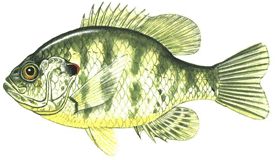Back to Previous Page
REDEAR SUNFISH

At-a-Glance
- Scientific Name: Lepomis microlophus
- Found in Illinois: Statewide
- State Average: 6.5"
- State Record: 3 lbs/1.1 oz (2018)
- Best Lures: crickets, red and wax worms, and night crawlers
- Top 3 Lakes (based on average size): Cedar, Devil's Kitchen, Randolph County
Habitat:
The redear sunfish will thrive in most warm-water lakes and streams. It is a lover of deep water and usually stays there except during the spawning period. This fish will congregate about brush, logs and stumps — hence its local name of "stump-knocker."
Feeding and Habits:
The redear sunfish eats food similar to that of the bluegill. Food consists largely of insect larvae, snails and cladocerans. They will feed on minute plant and animal life when the fish are small, but as they grow larger they will eat various insects and insect larvae (primarily midge fly larvae and blood worms), various crustaceans and snails. When eating snails, the shell is completely crushed and most of it is expelled from the mouth. To crack hard shells, redears have specially modified teeth in their throat and is how the red-ear received the name "shell-cracker." The red-ear spends much of its time in deep water and seldom feeds on surface insects like the bluegill.
Reproduction:
The redear sunfish will reproduce when it is one year old. In the spring (May–June) when water temperatures reach around 68Fº, male redear move into the shallows to build their nests. When a female approaches the nest, the two fish swim around over the nest in circular fashion and form a V figure with their vents pressed together. The female releases eggs on each dip, and the male simultaneously releases milt (sperm). The eggs are fertilized as they fall into the nest. Several spawnings may occur after which the female leaves and the male redear takes a position over the nest to guard the eggs from predators and to fan the water above the eggs so it will circulate and aerate the eggs until they hatch. After hatching, the fry will stay in the nest for about a week with a male still standing guard. After this time, they leave the nest in search of food and then they are on their own. Breeding males can be distinguished from the females by the darker colored head, gill covers and body and the lack of a pot-bellied appearance.



